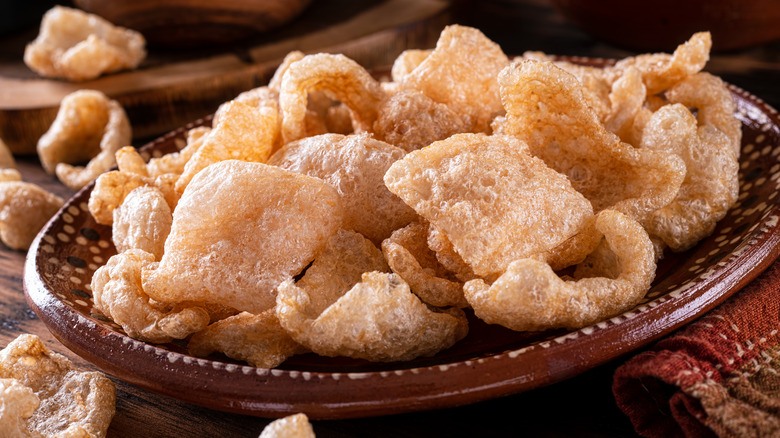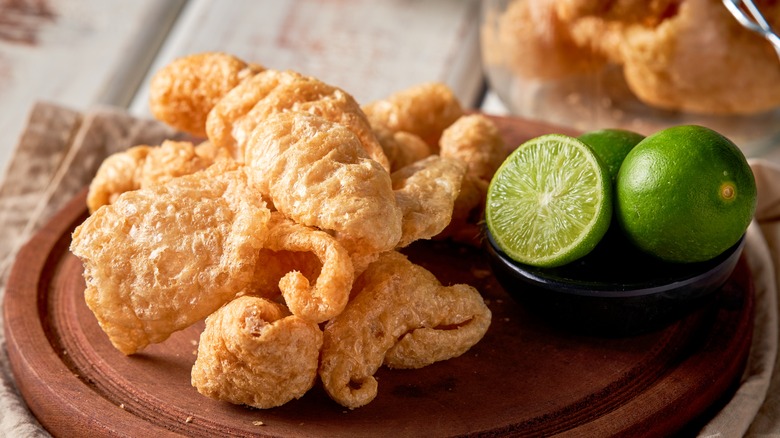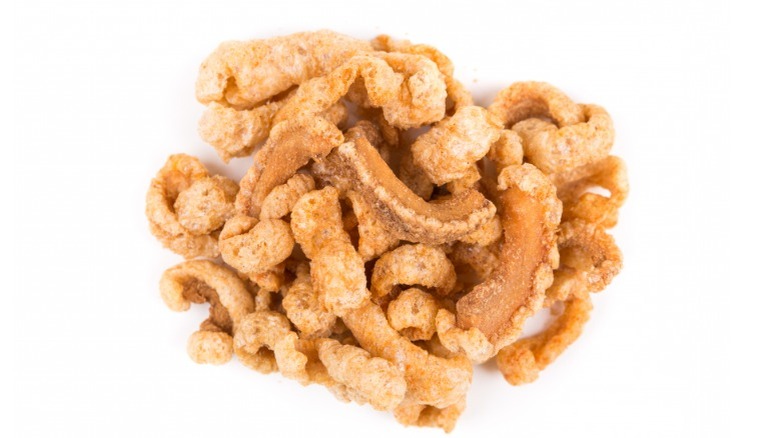Is There A Difference Between Pork Rinds And Cracklins?
If you ask a group of people about their favorite road trip snacks, you're likely to hear at least one person say pork rinds — or cracklins (also called cracklings) — or both. So, what's the difference between these Southern snacks?
Pork rinds and cracklins have a lot in common. They come from the same animal, and both have rich histories dating back centuries. They're both fried in oil and are rich in porky, delicious flavor (sometimes with additinal spicy and sweet spice blends like lime, barbeque, and cayenne pepper), but are they the same thing? Not exactly.
Pork rinds and cracklins are both from the skin of a pig and the layers of fat and meat directly underneath the leathery exterior, but the real difference between the two snacks is in the fat content and how the skin is butchered before hitting the hot oil for frying.
Pork rinds are made from pork skin only
To make pork rinds, the only part of the pig used is the skin. The process begins by boiling the pork skin, then chilling it for several hours so any remaining fat can be removed. The skin is then put in the oven to dry out and remove any leftover moisture. If you've ever fried anything wet, you'll know that's an important step to avoid the hot oil from popping and potentially burning the cook. After it's time in the oven, the skin is fried in hot peanut oil or lard, drained, and then tossed in a variety of savory seasonings.
The melt-in-your-mouth, popping crunch you get when biting into a pork rind is thanks to the air pockets created when pork skin meets the fryer oil. Pork rinds puff when they're fried because the moisture in the skin evaporates during the cooking process, leaving air pockets in the snack.
Although widely popular in the South, pork rinds are available all over the United States and can be found in almost any gas station convenience store, grocery store, or even sometimes freshly fried from a roadside stand.
Cracklins are pork skin plus fat
Cracklins are very similar to pork rinds but are made with more than just pig skin. Instead, cracklins are created by leaving a small amount of fat (and sometimes morsels of meat) on the pork skin and frying it. Some cracklins are even made using whole chunks of pork belly. This extra fat and meat, stop cracklins from puffing up and make cracklins a meatier snack than pork rinds. They're heavier, chewier, and have a stronger pork flavor, which is sometimes missing in traditional pork rinds.
Similar to pork rinds, cracklins are fried in hot peanut oil or lard, but they're usually double-dipped — first in fat to render the pork fat and then again to crisp and cook the skin until it "cracks" or bubbles. Cracklins are then drained and tossed with salt and the desired spices.
Cracklins likely originated as a byproduct of rendering pork fat; and instead of being tossed in the trash, were seasoned with salt and spices and enjoyed as a snack. Today they are a mainstay of Cajun cuisine, and although they may be less readily available in grocery stores than pork rinds, they can often be found on menus in Cajun and Southern restaurants.
While similar, the preparations for pork rinds and cracklins make them distinct snacks that are both worth a try. But if you're in the mood for a crunchy, porky, savory snack, either will do just fine.


